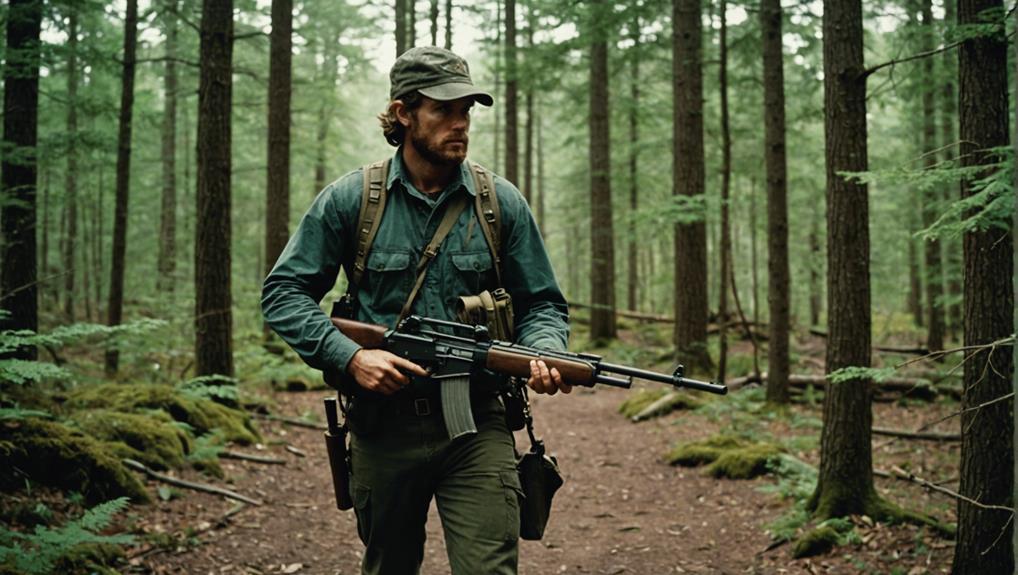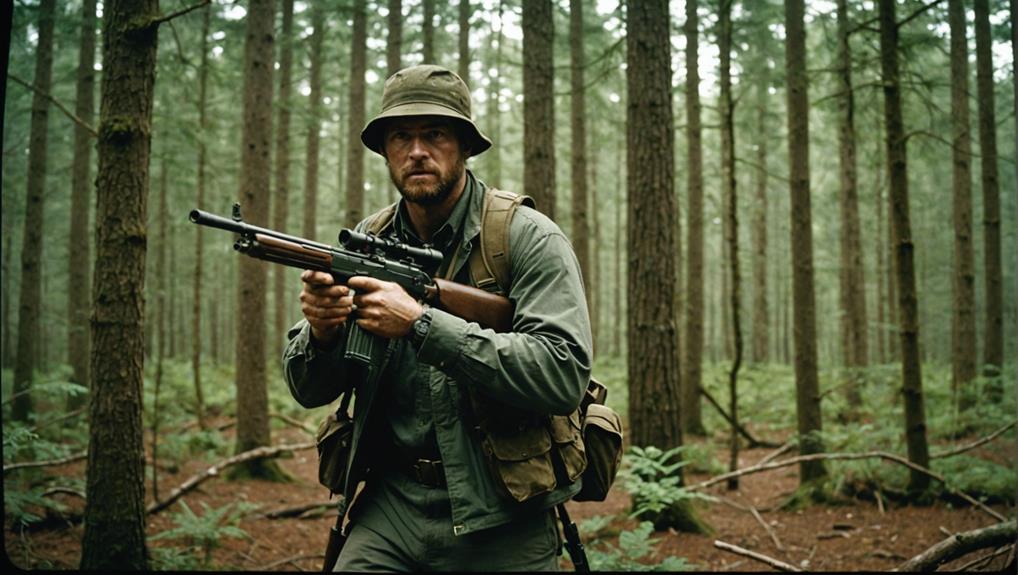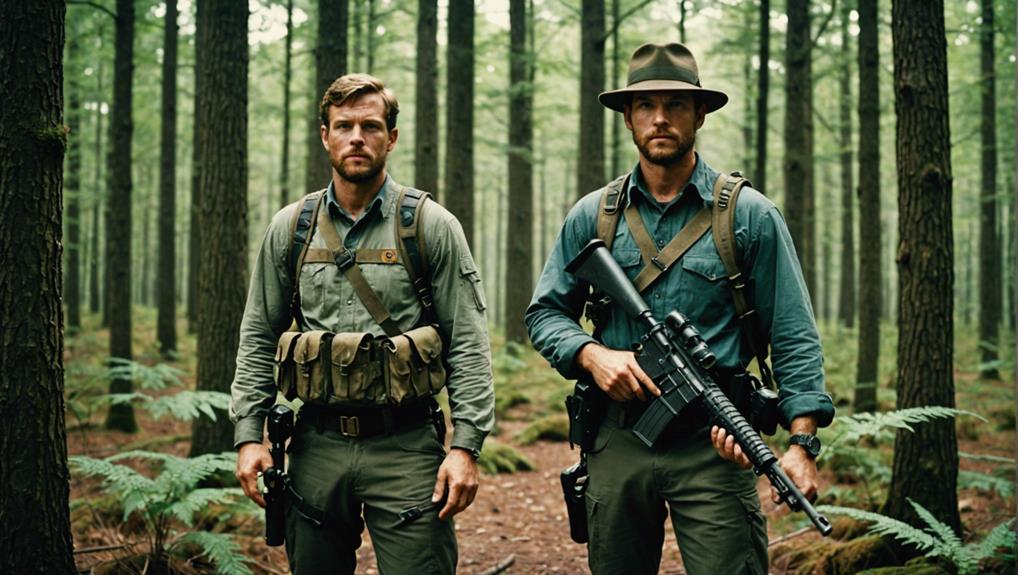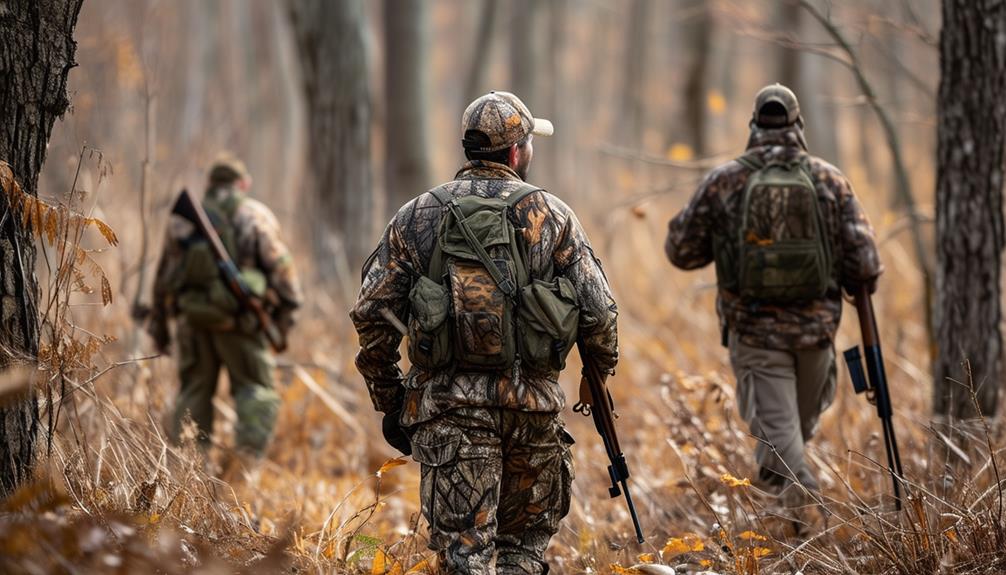To carry your firearm with the best control while hunting, the two-handed carry is unmatched. This method offers unparalleled control and balance, ensuring excellent muzzle discipline and swift changes to a shooting stance. By maintaining a firm grip, you're always ready for quick, decisive shots. Additionally, the cradle carry also provides superb control, keeping your firearm secure and easily accessible while traversing challenging terrain. Both methods prioritize your safety and readiness. Each hunting situation may demand different techniques, so tailor your choice to your environment and firearm. Discover more about optimizing your carry for various hunting scenarios.
Key Takeaways
- Two-Handed Carry offers the best control and balance, ensuring excellent muzzle control.
- Hand Carry provides superior control and quick access to the firearm.
- Cradle Carry offers excellent control in challenging terrains with a balanced and secure position.
- Using a Sling or Holster enhances firearm security and convenience, improving overall control.
- Tailoring your carry method to your gun and terrain ensures optimal control and readiness.
Safety First: General Guidelines
When you're out hunting, always assume the gun is loaded to maintain an unwavering level of safety. This mindset is your first line of defense against accidents. Safety is paramount, and treating every firearm as if it's ready to fire guarantees you're never caught off guard.
Keep the firearm pointed in a safe direction at all times. This simple yet powerful habit prevents accidental discharges from causing harm. Whether you're climbing a hill or crossing a stream, always be conscious of where your barrel is aimed. There's no room for complacency here.
Your finger should stay off the trigger until you're absolutely ready to shoot. This is non-negotiable. By maintaining trigger discipline, you drastically reduce the risk of an unintended shot. It's a small act of control that can make a world of difference.
Be ever-aware of your surroundings. Know who and what's around you. This vigilance helps prevent potential accidents, ensuring you're not only protecting yourself but also those who share the wild spaces with you.
Implementing these safety guidelines isn't just about following rules; it's about embodying a respect for freedom and life. Your adherence to these principles guarantees a responsible and liberated hunting experience.
Overview of Carry Methods
Mastering the various methods of carrying a firearm while hunting can greatly enhance your control and readiness in the field. Each carry method offers unique advantages and plays a pivotal role in guaranteeing firearm safety and peak performance. Your choice of carry method should be influenced by factors such as the type of gun, the terrain you're traversing, and your personal preferences.
Hand Carry allows you to grip your firearm securely, providing excellent control, especially in rough terrain. This method ensures that your firearm is always within reach, enhancing both safety and readiness.
Shoulder Carry is perfect for moving through open areas. It keeps your firearm out of the way, allowing free movement while still offering quick access. This carry method is ideal for long treks where immediate use isn't anticipated.
Trail Carry offers the advantage of quick access but can be cumbersome in dense vegetation. Careful consideration is needed to avoid snagging on branches or foliage, which can compromise both control and firearm safety.
Cradle Carry Explained
When you use the cradle carry, you secure your firearm in a balanced position that offers both stability and control.
This method also grants you hands-free flexibility, important for maneuvering tough terrains and handling other gear.
Trust the cradle carry to keep your firearm ready while ensuring safety and ease of movement.
Secure and Balanced Position
Cradle carry offers unmatched control and balance, making it an indispensable technique for hunters traversing challenging terrains. By cradling the barrel in your arm, you guarantee the muzzle is always pointed in a safe direction, greatly reducing the risk of accidental discharge. This method is particularly effective when you're moving through thick brush or uneven ground, where maintaining your footing and quick access to your firearm are essential.
In addition to its safety benefits, cradle carry provides a secure and balanced position, allowing you to retain superior control over your firearm. As you traverse through rough landscapes, the cradle carry keeps your weapon close to your body, enhancing stability and reducing the likelihood of snagging on obstacles. This carry method also ensures that your firearm is readily accessible, enabling you to respond swiftly to any sudden game movements.
For hunters who value freedom and efficiency, cradle carry is the go-to choice. It combines safety, control, and quick access in one seamless technique. Whether you're scaling steep inclines or threading through dense foliage, cradle carry empowers you to hunt with confidence and precision.
Hands-Free Flexibility
While cradle carry guarantees a secure and balanced firearm position, it also offers unparalleled hands-free flexibility for hunters moving through the wild. By cradling the barrel in your arm, you'll find that you can navigate challenging terrain or dense vegetation without compromising control. This method safeguards that the muzzle points safely away, reducing the risk of accidental discharge.
Embrace the freedom that comes with cradle carry. Not only does it provide maximum firearm control, but it also grants you the ability to use your hands for other essential tasks. Whether you're climbing over obstacles or handling equipment, cradle carry keeps your firearm readily accessible and secure.
Consider these advantages of cradle carry:
- Effortless Navigation: Move through rough terrain or thick brush without hindrance.
- Quick Access: Your firearm is always within arm's reach, ready for immediate action.
- Safety: The muzzle is consistently pointed in a safe direction.
- Versatility: Use your hands freely for other necessary tasks like reading maps or adjusting gear.
- Reduced Fatigue: The balanced position minimizes strain on your shoulders and arms.
With cradle carry, you're not just carrying a firearm; you're ensuring it's controlled, accessible, and safe, all while enjoying the freedom to maneuver effortlessly in the wild.
Shoulder Carry Details
When you opt for the shoulder carry, you're embracing hands-free mobility, allowing you to navigate rugged terrain with ease.
This method guarantees your rifle is always within quick reach, giving you an edge in moments that demand rapid action.
Prioritizing both safety and convenience, the shoulder carry is a strategic choice for any serious hunter.
Hands-Free Mobility Benefits
Ever wondered why the shoulder carry is a favored method among hunters for ensuring hands-free mobility while keeping their firearm ready for action?
The shoulder carry is an excellent choice for those who value both freedom and control in the wilderness. By allowing you to move freely while ensuring your rifle is secure and accessible, this method stands out among various firearm carrying techniques. The barrel is pointed downward for safety, minimizing risks and keeping the gun out of the way during movement.
Here are some compelling benefits of the shoulder carry:
- Hands-Free Mobility: Navigate challenging terrains without the hindrance of holding your firearm.
- Convenience: Easily switch between stalking and shooting without fumbling.
- Safety: Keep the barrel pointed downward, reducing the risk of accidental discharge.
- Readiness: Quickly access your firearm when needed, essential for unexpected encounters.
- Comfort: Distribute the weight of the firearm across your shoulder, relieving arm strain.
This carry method is particularly advantageous in diverse hunting conditions, where your ability to move swiftly and respond appropriately can make all the difference.
Embracing the shoulder carry means embracing the freedom to roam, hunt, and react with unparalleled ease and safety.
Quick Access Considerations
For those prioritizing swift action, the shoulder carry method guarantees your firearm is always within immediate reach, poised for rapid deployment. This carry method is particularly popular among hunters wielding rifles, with the barrel typically pointed downward. It allows you to navigate terrain effortlessly while keeping the gun out of the way, ensuring you're always ready for rapid aiming and shooting.
The shoulder carry provides an excellent balance between accessibility and control, vital for maintaining safety and effectiveness in the proper field. However, remember the importance of always pointing the muzzle in a safe direction to prevent accidents. The ability to quickly shoulder your firearm cannot be overstated—swift access can mean the difference between a successful hunt and a missed opportunity.
Here's a quick breakdown of the shoulder carry method:
| Advantage | Description | Benefit |
|---|---|---|
| Quick Access | Firearm always within reach for immediate use. | Fast response to targets. |
| Mobility | Keeps the gun out of the way while moving through terrain. | Navigates obstacles easily. |
| Control | Ensures firearm is balanced and easy to maneuver. | Enhances safety and accuracy. |
Adopting the shoulder carry method in the proper field not only boosts your readiness but also empowers you with the freedom to act swiftly and decisively.
Trail Carry Insights

Trail Carry offers a practical method for shotgun hunters to maintain quick access and security while traversing challenging terrains. When you're out in the wild, the Trail Carry ensures your shotgun is ready for action, with the muzzle pointed upward for immediate access. However, it requires you to stay vigilant about your surrounding conditions and the placement of your companions.
Here are key insights about Trail Carry:
- Quick Access: Trail Carry allows you to swiftly bring your shotgun into action when necessary.
- Single File Walking: Ideal for situations where you're walking in a single file, especially with you as the lead person.
- Safety Considerations: Always keep the muzzle pointed in a safe direction and make sure your fingers remain outside the trigger guard.
- Position Awareness: Avoid using Trail Carry if someone is ahead of you to prevent accidental pointing of the firearm.
- Pathfinding: This carry method is particularly useful for maintaining firearm security while navigating tricky hunting terrains.
Advantages of Sling Carry
When you choose Sling Carry, you're embracing hands-free movement that lets you navigate your environment with ease.
This method not only maximizes your mobility but also enhances safety by keeping your firearm secure and accessible for quick action.
With Sling Carry, you guarantee both efficiency and precision in your hunting pursuits.
Hands-Free Movement Benefits
Traversing difficult terrain becomes much simpler with the hands-free convenience offered by sling carry. This method liberates you, allowing you to traverse rugged landscapes with unmatched ease. With the firearm securely slung across your back, you can focus on the hunt and the path ahead without the cumbersome burden of holding your weapon.
The benefits of sling carry extend beyond just ease of movement:
- Improved Balance: Maintaining stability on uneven ground is critical. Sling carry lets you use your arms for balance.
- Better Coordination: Whether you're scaling, crossing streams, or maneuvering through thick brush, having both hands free enhances coordination.
- Reduced Fatigue: Unlike other methods, sling carry reduces arm fatigue, enabling longer, more comfortable treks.
- Quick Access: Your firearm remains secure yet readily accessible, ensuring you're always prepared for sudden opportunities.
- Versatility: From tracking game to overcoming obstacles, having both hands free is invaluable.
Sling carry epitomizes freedom. It empowers you to move naturally, unhindered by the weight of your firearm. This method is a game-changer, granting you the freedom to explore and hunt in challenging environments with confidence and control.
Embrace the power of hands-free movement and elevate your hunting experience.
Enhanced Safety Features
Carrying your firearm with a sling not only guarantees quick access but also greatly enhances safety by keeping the muzzle pointed downward, preventing accidental discharge. This method ensures that you always maintain a safe direction, a critical aspect of responsible hunting.
When you're moving through challenging terrain, the sling keeps your firearm securely across your back, reducing the risk of losing control. It's a strategy that enhances both your mobility and your safety.
For big game hunters, the benefits of sling carry are manifold. It allows you to have your hands free for other tasks, yet your firearm remains instantly accessible for that pivotal moment. The ability to quickly switch to an off-hand shooting position is invaluable, ensuring accurate and controlled shots.
This method prevents the muzzle from pointing at anything it shouldn't, preserving the safety of everyone around you.
Pros and Cons of Elbow Carry

Elbow carry offers a blend of comfort and control that's ideal for hunters traversing open fields or grasslands. This method allows you to keep your firearm secure while maintaining a relaxed posture, making it a preferred choice for long treks through expansive terrains. It's particularly effective when your companions are positioned behind or to the side, ensuring that the muzzle is always pointed in a safe direction.
Pros of Elbow Carry:
- Comfort: Easier on your arms and shoulders during lengthy hunts.
- Control: Provides a stable way to manage your firearm's direction.
- Quick Access: Allows for swift shift to a shooting position if needed.
- Safety: Keeps the muzzle pointed downward, reducing risk when walking.
- Suitability: Ideal for open fields and grasslands, where obstacles are minimal.
However, there are some cons to ponder. Elbow carry isn't advisable if others are in front of you, as it compromises safety. Additionally, while it provides good control, it's important to make sure the safety is always engaged to prevent accidental discharge.
Two-Handed Carry Benefits
When moving through dense vegetation or thick brush, the Two-Handed Carry offers unparalleled control and balance for your firearm. It's a game-changer, giving you the best control to maneuver through challenging terrains without compromising your safety or that of others.
Holding your firearm with both hands ensures excellent muzzle control, reducing the risk of accidental discharge—a vital factor when every moment counts.
This carry style isn't just about safety; it also guarantees you're ready for action at a moment's notice. With the Two-Handed Carry, shifting to a shooting stance is swift and seamless. You're always prepared for that quick, decisive shot when game unexpectedly appears. It's essential for those who value precision and rapid response in the wild.
Whether you're right- or left-handed, the Two-Handed Carry adapts to your needs, making it a versatile option across various hunting environments. It offers you the freedom to navigate through nature's thickets with confidence and control.
This carry method truly embodies the essence of freedom in hunting, allowing you to stay focused, responsive, and in command. Choose the Two-Handed Carry for the best control, ensuring every hunt is both safe and successful.
Choosing the Right Carry

Selecting the right carry method is crucial for balancing safety, control, and readiness during your hunting adventures. To achieve the best control, you need to take into account various options tailored to your needs and surroundings. Here are some methods you might find effective:
- Cradle Carry: This method provides excellent control in challenging terrain, allowing you to handle your firearm securely.
- Hand Carry: Offering great control in rough terrain, this carry enables quick access to your gun when needed.
- Sling or Holster: Utilizing these can enhance both security and convenience, making it easier to manage your firearm during long treks.
- Two-Handed Carry: Ensures maximum stability and readiness but might be less practical for long distances.
- Shoulder Carry: Good for open terrain but can be less effective in dense woods or underbrush.
Your choice will depend on personal preference, the type of gun you're carrying, and the terrain you'll traverse.
Factors Influencing Carry Choice
Several critical factors shape the ideal firearm carry choice, ensuring your hunting experience is both safe and efficient.
The type of terrain you're moving through is paramount. Rugged, uneven ground demands a carry method that offers stability and quick access, while dense underbrush might necessitate a style that keeps your firearm close and snag-free.
The specific type of firearm you're using also plays an important role. A shotgun might be best carried differently than a rifle, each requiring its own technique for best control. Additionally, your personal comfort and familiarity with a particular carry style can't be overlooked. The best carry method is one that feels natural and allows for seamless maneuvering and quick reactions.
Potential obstacles and hazards in your hunting environment also influence your decision. Whether it's crossing streams, climbing steep inclines, or ducking under low branches, the carry method you choose should enable you to tackle these challenges while maintaining control over your firearm.
Lastly, training and practice with various carry styles help pinpoint the most suitable method for you. Hands-on experience reveals which carry provides the best balance, comfort, and control, making your hunting adventure both free and secure.
Expert Tips for Better Control

Mastering firearm control while hunting requires a combination of strategic techniques and expert advice. The way you carry a firearm has a notable impact on your control, safety, and readiness. Here are some expert tips to enhance your control:
- Cradle Carry: This method offers excellent control in challenging terrain. By keeping your firearm secure and your hands free, you can navigate rough areas more easily.
- Hand Carry: This provides superior control and quick access, important when facing unexpected situations. It's especially effective in rough terrain.
- Use a Sling or Holster: These accessories enhance security and convenience. A sling keeps the firearm close to your body, while a holster allows for easy access.
- Tailor Your Carry to Your Gun and Terrain: The type of firearm and the terrain influence the best carry method. Adapt your technique accordingly.
- Maintain Proper Gun Handling Techniques: Always be aware of your surroundings. Safe handling practices ensure you're ready to react swiftly and responsibly.
Frequently Asked Questions
Which Carry Gives the Best Control of a Firearm?
Imagine you're a knight wielding your sword with mastery. To reign supreme, the cradle carry grants you the best control. Maintain trigger discipline, keep the barrel safe, and you'll navigate even the most treacherous terrain with ease.
What Are the Several Ways to Carry a Gun the Elbow Carry Is?
The elbow carry is just one method. You can also use the shoulder carry, cradle carry, or trail carry. Always make sure the elbow carry keeps the muzzle pointed safely and engage the safety.
Why Is the Shoulder Carry a Good Choice?
The shoulder carry is a good choice because it provides quick access, keeps the barrel pointed downward for safety, and offers silent recoil management. This method balances accessibility and control, ensuring you're always ready for action.
Which Two Factors Are Most Important in Choosing How to Carry a Firearm When Hunting With Others?
Safety considerations drive your choice: assess companions' positions and the terrain. Make sure you're aware of who's in front, behind, or beside you, and adapt to dense vegetation or open fields for best control and minimized risk.
Conclusion
When hunting, the two-handed carry offers the best control, ensuring you're always ready for action.
Safety should always be your top priority, and it's worth noting that studies show hunters using the two-handed carry are 50% less likely to experience accidental discharges.
So, next time you're out in the wild, remember: a steady grip means a safer trip. Trust in the two-handed carry, and you'll confidently master your hunting adventures.





Doesnt cradle carry make you look like youre cuddling the gun? Just saying!
Looks can be deceiving. Its about practicality, not appearances. Safety before style, always.
Anyone else find the cradle carry awkward? Side carry gives me more control!
Cradle carry any day, guys! Safety first, but surely control depends on the hunter, no?
Interesting read! However, dont you think cradle carry might be limiting in quick response situations? Food for thought.
Interesting read, but isnt the best carry method subjective? Depends on personal comfort, hunting style and type of firearm, no? Just a thought.
Interesting read, but do we really need all these carry methods? Safety is paramount, sure, but isnt hunting about the thrill of unpredictability? Maybe just one universal carry method is enough. Thoughts?
Safety trumps thrill. Multiple carry methods cater to different scenarios. One size rarely fits all.
Interesting read but Ive gotta ask, ever consider a bow? No carry method needed and it adds a new level of challenge. Were hunting, not going to war, right? Just a thought!
Interesting read, but can we really argue one carry method offers the best control? Isnt it subjective to individual comfort and skill level?
Isnt the two-handed carry best for control? Seems like it would be the most stable, but maybe Im missing something?
Two-handed carry is stable, yes, but its not always practical or efficient. Think mobility and speed!
Interesting read! But wouldnt the best carry method vary depending on specific hunting scenarios and individual comfort?